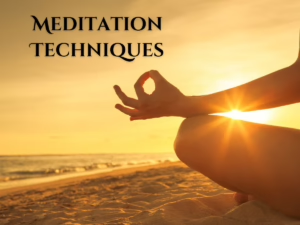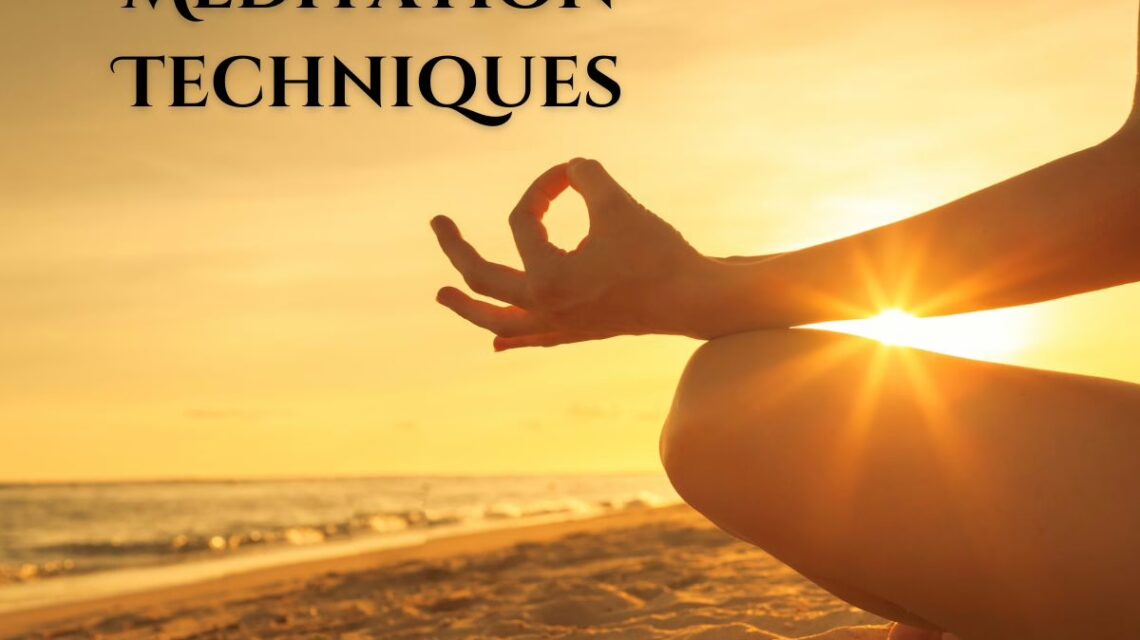
06 Meditation Techniques: In today’s fast-paced world, stress and anxiety have become common companions for many. The constant pressure to perform, meet deadlines, and juggle multiple responsibilities can take a toll on mental health. Meditation offers a refuge from the chaos, providing a means to center oneself, find inner peace, and cultivate a sense of calm. This blog explores six effective meditation techniques that can help relieve stress and anxiety, offering a detailed guide on how to practice each method and its benefits.
Overview
Mindfulness meditation is a practice rooted in Buddhist traditions that involves paying attention to the present moment without judgment. This technique encourages practitioners to become aware of their thoughts, feelings, and sensations, helping them to develop a non-reactive awareness of their experiences.
How to Practice
- Find a Quiet Space: Choose a quiet and comfortable place where you won’t be disturbed.
- Sit Comfortably: Sit in a chair or on the floor with your back straight. You can also lie down if that is more comfortable.
- Focus on Your Breath: Close your eyes and bring your attention to your breath. Notice the sensation of the air entering and leaving your nostrils or the rise and fall of your chest.
- Observe Your Thoughts: As you meditate, various thoughts will arise. Instead of engaging with them, simply observe them and let them pass like clouds in the sky.
- Return to Your Breath: Whenever you find your mind wandering, gently bring your focus back to your breath.
Benefits
- Reduces stress by promoting a sense of calm and relaxation.
- Enhances emotional regulation and reduces symptoms of anxiety and depression.
- Improves concentration and focus.
- Increases self-awareness and promotes a non-judgmental attitude towards oneself.
Overview
Guided meditation involves listening to a recorded meditation led by a teacher or guide. This technique is particularly helpful for beginners as it provides structure and direction, making it easier to focus and relax.
How to Practice
- Choose a Guided Meditation: Select a guided meditation that suits your needs. There are many available online, covering various topics such as stress relief, anxiety reduction, and relaxation.
- Find a Comfortable Position: Sit or lie down in a comfortable position in a quiet space.
- Listen and Follow the Instructions: Put on your headphones and listen to the guide’s instructions. Allow yourself to be led through the meditation, focusing on their voice and following their cues.
- Engage with the Visualization: Many guided meditations include visualizations. Engage with these mental images to enhance relaxation and focus.
Benefits
- Provides structure and guidance, making it easier for beginners to meditate.
- Helps to reduce stress and anxiety by promoting relaxation and a sense of well-being.
- Can be tailored to specific needs, such as sleep improvement or stress reduction.
- Encourages the use of imagination and visualization to enhance the meditation experience.
Overview
Transcendental Meditation (TM) is a technique that involves the use of a mantra—a specific word or sound—to help the mind settle into a state of restful awareness. This practice was popularized by Maharishi Mahesh Yogi in the 1950s and has since gained widespread recognition for its benefits.
How to Practice
- Receive Instruction: TM is typically taught by certified instructors. It involves a personalized mantra given to the practitioner.
- Sit Comfortably: Sit in a comfortable position with your eyes closed.
- Repeat the Mantra: Silently repeat your mantra in your mind. If your mind wanders, gently return to the mantra.
- Practice Regularly: TM is usually practiced for 20 minutes, twice a day.
Benefits
- Reduces stress and promotes a deep state of relaxation.
- Improves overall mental health by reducing symptoms of anxiety and depression.
- Enhances clarity of thought and creativity.
- Provides a structured and disciplined approach to meditation.
Overview
Body scan meditation is a technique that involves paying attention to different parts of the body in a systematic manner. This practice helps to develop a heightened awareness of bodily sensations and promotes relaxation.
How to Practice
- Lie Down Comfortably: Lie down on your back in a comfortable position, preferably on a yoga mat or a bed.
- Close Your Eyes: Close your eyes and take a few deep breaths to relax.
- Focus on Your Body: Starting from the toes, gradually move your attention upwards through the body. Notice any sensations, tension, or discomfort in each area.
- Release Tension: As you become aware of tension in any part of the body, consciously release it and relax that area.
- Continue Upwards: Continue this process until you reach the top of your head.
Benefits
- Promotes relaxation and reduces stress by releasing physical tension.
- Enhances body awareness and mindfulness.
- Helps to alleviate chronic pain and improve sleep quality.
- Encourages a deeper connection between mind and body.
5. Loving-Kindness Meditation
Overview
Loving-kindness meditation, also known as Metta meditation, is a practice that involves cultivating feelings of compassion and love towards oneself and others. This technique is rooted in Buddhist traditions and is aimed at fostering a sense of interconnectedness and empathy.
How to Practice
- Find a Quiet Space: Choose a quiet place where you won’t be disturbed.
- Sit Comfortably: Sit in a comfortable position with your back straight and eyes closed.
- Generate Feelings of Compassion: Begin by focusing on yourself. Repeat phrases like “May I be happy, may I be healthy, may I be safe, may I live with ease.”
- Extend Compassion to Others: Gradually extend these feelings to others, starting with loved ones, then acquaintances, and finally, to all beings.
- Visualize and Feel: Visualize the people you are directing these feelings towards and feel the compassion and love flowing from your heart to theirs.
Benefits
- Reduces stress and anxiety by promoting positive emotions.
- Enhances emotional resilience and empathy.
- Improves relationships and fosters a sense of interconnectedness.
- Encourages a positive and compassionate mindset.
6. Breath Awareness Meditation
Overview
Breath awareness meditation is a simple yet powerful technique that involves focusing on the breath. This practice helps to calm the mind and reduce stress by bringing attention to the present moment.
How to Practice
- Find a Quiet Space: Choose a quiet place where you won’t be disturbed.
- Sit Comfortably: Sit in a comfortable position with your back straight and eyes closed.
- Focus on Your Breath: Bring your attention to your breath. Notice the sensation of the air entering and leaving your nostrils or the rise and fall of your chest.
- Observe Without Control: Simply observe your breath without trying to control it. Allow it to flow naturally.
- Return to the Breath: Whenever your mind wanders, gently bring your focus back to your breath.
Benefits
- Promotes relaxation and reduces stress by calming the mind.
- Enhances concentration and focus.
- Increases self-awareness and mindfulness.
- Provides a simple and accessible meditation practice that can be done anywhere.
Meditation offers a powerful tool for managing stress and anxiety, providing a path to inner peace and mental clarity. Whether you choose mindfulness meditation, guided meditation, Transcendental Meditation, body scan meditation, loving-kindness meditation, or breath awareness meditation, each technique has unique benefits that can help you navigate the challenges of modern life. By incorporating these practices into your daily routine, you can cultivate a sense of calm and resilience, enhancing your overall well-being. Remember, the key to successful meditation is consistency and patience. Start with a few minutes each day and gradually increase the duration as you become more comfortable with the practice.
Also Read –
https://festivaldealsrush.com/best-4-health-and-wellness-home-remedies/

